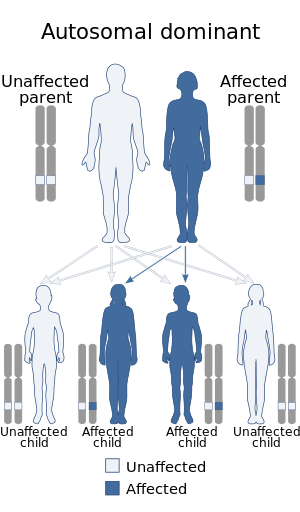Medullary cystic kidney disease
| Medullary cystic kidney disease | |
|---|---|
 |
|
| Medullary cystic kidney disease has an autosomal dominant pattern of inheritance | |
| Specialty | medical genetics |
| Types | MCKD1 and MCKD2 |
| Diagnostic method | Kidney biopsy, Kidney ultrasound, CBC |
| Medication | Currently no cure, Drink plenty of fluids, Salt supplement |
| Classification |
· ·
|
|---|---|
| External resources |
Medullary cystic kidney disease (MCKD) is an autosomal dominant kidney disorder characterized by tubulointerstitial sclerosis leading to end-stage renal disease. Because the presence of cysts is neither an early nor a typical diagnostic feature of the disease, and because at least 4 different gene mutations may give rise to the condition, the name autosomal dominant tubulointerstitial kidney disease (ADTKD) has been proposed, to be appended with the underlying genetic variant for a particular individual. Importantly, if cysts are found in the medullary collecting ducts they can result in a shrunken kidney, unlike that of polycystic kidney disease. There are two known forms of medullary cystic kidney disease, mucin-1 kidney disease 1 (MKD1) and mucin-2 kidney disease/uromodulin kidney disease (MKD2). A third form of the disease occurs due to mutations in the gene encoding renin (ADTKD-REN), and has formerly been known as familial juvenile hyperuricemic nephropathy type 2.
In terms of the signs/symptoms of medullary cystic kidney disease, the disease is not easy to diagnose and is uncommon. In this condition, loss of kidney function occurs slowly over time, however the following signs/symptoms could be observed in an affected individual:
Some individuals with this disease develop gout, which is a condition in which patients develop severe pain and swelling in the big toe or another joint such as the knee. If untreated, it becomes chronic and affects the joints most of the time, instead of intermittently.
Normal individuals have two copies of the MUC1 and UMOD genes. The genes produce the protein mucin-1 and uromodulin, respectively. These proteins are expressed only in certain cells in the kidney – the thick ascending limb of Henle and distal convoluted tubule – both parts of the kidney tubule. The protein coats the surface of the tubule and protects the tubule.
In MKD, individuals have one normal and one abnormal MUC1 gene. In uromodulin kidney disease (UKD), individuals have one normal and one abnormal UMOD gene. The abnormal (mutated) gene produces a misfolded protein product that deposits within cells of the renal tubules (in a part of the cell called the endoplasmic reticulum). The abnormal protein builds up in the cell and causes it slowly to die, leading to an ultimate loss of the kidney's function manifesting as a disease state.
...
Wikipedia
